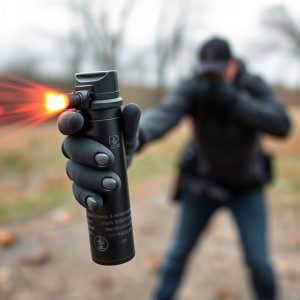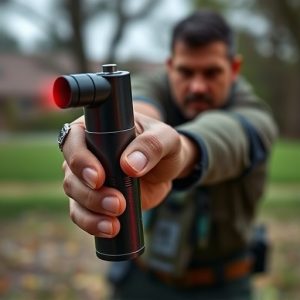Non-Lethal Pepper Spray: Your Civilian Self-Defense Toolkit
Non-lethal pepper spray defense, employing oleoresin capsicum (OC) spray derived from chili peppers,…….
Non-lethal pepper spray defense, employing oleoresin capsicum (OC) spray derived from chili peppers, is a powerful and safe self-defense option. It temporarily incapacitates attackers by irritating eyes and respiratory systems, providing users with crucial escape time. Ideal for civilians seeking personal protection at home or outdoors, it offers peace of mind in potentially dangerous situations. Choosing the right pepper spray involves considering strength, range, weather resistance, ease of use, and legal guidelines, which vary across jurisdictions. Proper usage includes strategic targeting of facial areas as a last resort to disable aggressors temporarily. Reputable training is essential for safe and effective deployment.
“In today’s uncertain world, civilians are seeking effective personal protection tools. One increasingly popular option is non-lethal pepper spray, a powerful defensive tool that can deter and disable assailants without causing permanent harm. This article delves into the mechanics and effectiveness of pepper spray, guiding readers through choosing the right product, understanding legal considerations, and mastering safe handling practices. Armed with knowledge, individuals can empower themselves for enhanced personal security.”
- Understanding Non-Lethal Pepper Spray: A Civilian's Defense Tool
- The Mechanism and Effectiveness of Pepper Spray in Self-Defense
- Choosing the Right Pepper Spray for Personal Protection
- Legal Considerations and Usage Guidelines for Civilians
- Safety Precautions and Best Practices for Carrying and Using Pepper Spray
Understanding Non-Lethal Pepper Spray: A Civilian's Defense Tool
Non-lethal pepper spray is a powerful yet safe tool for civilian self-defense, designed to incapacitate and deter potential attackers without causing serious harm. Unlike traditional firearms or other lethal options, this spray is specifically formulated to be non-deadly, making it an appealing choice for individuals seeking protection in various settings, from personal safety at home to outdoor activities like hiking or camping.
The primary active ingredient in non-lethal pepper spray is capsaicin, the chemical that gives chili peppers their heat. When sprayed into the eyes and face, capsaicin irritates the mucous membranes, leading to temporary blindness, tears, coughing, and difficulty breathing. This disruption can buy time for a civilian to escape or disable an attacker. However, the effects are typically short-lived, and victims usually recover quickly without lasting physical damage. Such spray is easily portable, allowing individuals to carry it conveniently for added peace of mind in potentially dangerous situations.
The Mechanism and Effectiveness of Pepper Spray in Self-Defense
Pepper spray, also known as oleoresin capsicum (OC) spray, is a non-lethal self-defense tool that has gained significant popularity among civilians seeking protection. Its mechanism involves the release of capsaicin, the active ingredient found in chili peppers, which irritates the eyes and respiratory system when inhaled. This irritation causes temporary blindness, coughing, and difficulty breathing, providing the user with crucial time to escape or deter an attacker.
The effectiveness of pepper spray lies in its ability to incapacitate an assailant without causing serious harm. It can disrupt a person’s balance and coordination, making it harder for them to continue attacking or pursuing their victim. Studies have shown that when used properly, pepper spray has a high success rate in disabling aggressors, allowing users to defend themselves until help arrives. Its non-lethal nature makes it an attractive option for personal protection, especially in situations where lethal force might not be justified.
Choosing the Right Pepper Spray for Personal Protection
When considering a non-lethal pepper spray for personal protection, it’s crucial to understand your specific needs and environmental factors. Different pepper sprays offer varying levels of strength, range, and duration, so selecting the right one depends on your potential threats and how you plan to deploy it. For instance, if you’re concerned about close-quarters encounters, a powerful, short-range spray might be suitable, while longer-range options are better for keeping attackers at bay.
Additionally, features like weather resistance, ease of use, and carrying convenience should guide your choice. Consider the spray’s can design and whether it’s designed for one-hand operation in stressful situations. Also, check for automatic actuation mechanisms that activate on impact, ensuring a quick response. Always opt for reputable brands that provide clear instructions and safety guidelines to guarantee effective self-defense without causing unnecessary harm.
Legal Considerations and Usage Guidelines for Civilians
When considering defensive spray as a civilian protection tool, it’s crucial to understand the legal implications and usage guidelines that come into play. The use of non-lethal pepper spray defense is regulated by local, state, and federal laws, which vary significantly across different jurisdictions. It’s essential for civilians to familiarize themselves with these regulations before purchasing and carrying any form of defensive spray.
Usage guidelines typically include rules on where and how the spray can be deployed, as well as who is permitted to carry it. Many areas have restrictions on the strength or volume of the spray allowed, while others require specific training or certifications for its legal use. Respecting these guidelines not only ensures compliance with the law but also maximizes safety during potentially threatening situations.
Safety Precautions and Best Practices for Carrying and Using Pepper Spray
When carrying non-lethal pepper spray for civilian protection, safety should be your top priority. Always store the spray in a secure, easily accessible location, out of reach of children and unauthorized individuals. Keep it charged and regularly inspect the expiration date to ensure its effectiveness. Familiarize yourself with local laws regarding self-defense weapons; understanding your rights and restrictions is crucial before considering any defensive action.
Using pepper spray requires a strategic approach. Aim for the face, eyes, and nose to maximize its impact while minimizing harm to bystanders. Practice target acquisition and learn proper spraying techniques from reputable training sources. Remember, pepper spray is meant to disable an aggressor temporarily, allowing you to escape or call for help; it should be used as a last resort when facing imminent physical harm.
Defensive spray, particularly non-lethal pepper spray, offers civilians a powerful yet proportionate tool for self-defense. By understanding its mechanism, choosing the right product, and adhering to legal guidelines and safety practices, individuals can effectively protect themselves in various situations. Armed with knowledge and the proper equipment, folks can navigate potential threats with confidence, ensuring their safety and peace of mind.


